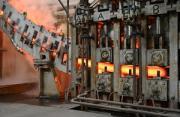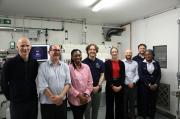UKAEA Pleads Guilty To Charges Under The Radioactive Substances Act
7th February 2007
UKAEA pleaded guilty on 6 February 2007 at Wick Sheriff Court to four charges under the Radioactive Substances Act 1960.
The charges related to the disposal of radioactive waste to a landfill site at Dounreay between 1963 and 1975, and the release of particles from the site to the environment on dates between 1963 and 1984. Sentence was deferred until 15th February 2007.
The Scottish Environment Protection Agency (SEPA), who reported these incidents to the Procurator Fiscal, carried out a lengthy investigation, examining UKAEA's business records and interviewed both current and former employees in a bid to identify the origin of the recovered fuel particles.
SEPA's chief executive Campbell Gemmell said the case clearly highlighted that pollution is avoidable: "This outcome serves as a valuable lesson to UKAEA and others that poor waste management practices will not be tolerated. Our message to everyone that we regulate is that we will help you to do the right thing. However, if you don't take your responsibilities seriously, we will take strong action.
"UKAEA has cleaned-up its act significantly and is making strenuous efforts to safely dismantle the Dounreay site, which is no easy job. As part of our commitment to better regulation we will support them in doing this, as we support other operators who are serious about the environment. However, we are still the 'watchdog' on behalf of the public. I sincerely hope that we do not need to use our powers again, but we will do so if that is necessary
Speaking outside the court following the case, UKAEA Director of Safety Dr John Crofts said: "We have pleaded guilty to all four charges which relate to events in the early years of the site. While those who pioneered the fast reactor experiment at Dounreay can be rightly proud of their achievements, today's case recognises that some mistakes were made.
"UKAEA deeply regrets that some particles were released from the site. Our priority today is to rectify those errors and minimising their impact on the environment. The practices which gave rise to these particles ceased long ago and we are now focussed on our mission to remediate the site and deal with the particles issue.
"We are working very closely with SEPA and others, in particular the affected adjoining estate and our new business partners AMEC and CH2MHILL, to deliver innovative clean-up solutions to these legacies and ensure that current and future generations do not have to live with unacceptable risks inherited from yesterday's practices."
BACKGROUND INFORMATION
GENERAL
Dounreay was Britain's centre of fast reactor research and development from 1954 until 1994. Three reactors and variety of chemical and waste facilities were built, including plants for the reprocessing of spent fuel to recover plutonium and uranium for re-use as
new fuel.
The last reactor closed in 1994 and reprocessing ceased in 1996. The site is now closed and in the process of being demolished. Decommissioning is due to be complete by 2033 at a cost of �2.9 billion.
The site has been authorised to dispose of radioactive waste under conditions and limits laid down by successive regulatory bodies.
PARTICLES
Eighty per cent of particles found to date have been from materials test reactor fuel elements that were dismantled in water-filled ponds before being transferred to an acid dissolver for reprocessing - chemical separation of the waste from the re-usable material.
This involved removing excess material from the edges of the elements and resulted in accumulations of metallic swarf in the ponds, some of which contained fragments of the irradiated fuel.
The authorised disposal route for contaminated swarf that accumulated in the ponds was to the waste shaft and silo at Dounreay.
During cleaning of the ponds, which involved draining the water, some of this swarf entered the low-active liquid effluent drainage system.
The drainage system flowed to two settling tanks where the liquid was checked prior to discharge to sea from a diffusion chamber 600 metres offshore.
On other occasions, for example spillages of pond water, it is believed water containing particles also entered the surface water drains.
In late 1983, during routine monitoring around Dounreay to measure the impact of site operations on the environment, a radioactive particle was detected on the foreshore adjacent to the site.
In 1984, filters were installed on the ponds and other facilities that discharged effluent to the low-active drain.
In 1984, during routine monitoring a radioactive particle was detected at Sandside Beach.
Efforts to identify the cause of continuing periodic discoveries of particles on the Dounreay foreshore focussed on a spillage of contaminated pond water in 1965 to a surface water drain and losses during transfers of waste.
In 1997, following the discovery of particles on the seabed near the old effluent discharge point, attention focussed on discharges to sea via the low-active drain.
Improved monitoring technology in 1997 led to the discovery of more particles at Sandside Beach.
Dounreay Particles Advisory Group was established in 2000 to provide independent expert advice to SEPA and UKAEA.
In recent years, UKAEA has spent in the region of �10 million on research and monitoring to determine the scope of the pollution and recover particles.
To date, 1256 particles have been recovered off-site - 929 offshore, 244 Dounreay foreshore, 82 Sandside Beach and 1 Dunnet.
DPAG estimates there may be 5000 or so particles remaining in the sediment near the disused seabed outfall.
UKAEA is currently consulting on a short-list of 11 options for clean-up of the pollution.
Meantime, UKAEA is required to monitor local beaches to criteria regulated by the Scottish Environment Protection Agency.
At Sandside, the most affected beach used by the public, UKAEA is working with the land-owner to ensure particles are detected and
removed using appropriate equipment.
All particles found to date on beaches used by the public have been below the level of radioactivity that independent experts say would be a significant risk to health.
Particles considered by independent experts to be a significant risk to health have been found on the seabed near Dounreay and the foreshore at the site. Fishing has been prohibited in this area since 1997.
The Third Report of DPAG, including an updated health risk assessment. It can be found at http://www.sepa.org.uk/radioactivity/dpag
LANDFILL SITE
An estimated 46,000 sq. metres of rubble from construction activity was consigned to the landfill site at Dounreay.
The presence of radioactivity within the rubble is believed to be as a result of contaminated ground on site that was excavated and consigned to the landfill.
Tests carried out in recent years have detected spots of activity but none has been at a level considered significant in terms of health risk
The landfill site is no longer in use and UKAEA is in discussion with SEPA about its capping.
The charges relate to:
Unauthorised disposals of radioactive waste at Landfill 42 between 1963 and 1975;
failure to prevent fragments of irradiated nuclear fuel being discharged into the environment between 1963 and 1984;
the unauthorised disposal of fragments of irradiated nuclear fuel from a fuel storage pond to a surface water drain between 1964 and 1967;
the unauthorised disposals of solid radioactive waste to the conventional foul drainage and surface water drainage system, resulting from a spill at building D1251 in November 1965.
The court heard that between 1976 and 2006, a total of 1401 particles had been found, mostly from the local seabed and from Sandside Beach.
Hugh Fearn SEPA radioactive specialist explained the background to the charges: "Radioactive liquid waste was and still is disposed of from Dounreay to the sea
at the Pentland Firth via a long outfall. An authorisation was put in place in 1963 requiring that the authority use all reasonable practicable means to prevent the discharge of particulate matter effluent. However, on occasions this wasn't adhered to and no filtering process was in place to removed solid waste, resulting in a discharge of particles to the sea.
"The majority of the particles recovered have come from materials test reactor fuel elements which were dismantled in water filled ponds.
"Landfill 42, which contains building rubble and excavated material, was subjected to wave erosion during heavy tides between 1963 and 1975. Remedial work was required by SEPA at the time. Of the material pulled back from the danger of further erosion by the sea, 43 cubic metres proved to be radioactive waste and included six radioactive fuel fragments.
"The nature of the radioactive contamination has lasting consequences for the future and this is something which will need to be addressed by the polluter, UKAEA."
Anyone witnessing pollution is urged to report it straight away by calling SEPA's 24 hour pollution report line, 0800 80 70 60, giving as many details as possible so effective action can be taken.
Related Businesses
Related Articles
UKAEA develops 3D printing for fusion components
At its recently opened Central Support Facility (CSF), UKAEA has commissioned an electron beam additive manufacturing machine that can be used to incorporate tungsten into components, alongside a selective laser manufacturing machine. Fusion can play a key role in a global low carbon energy future.Advancing Fusion Remote Maintenance: Industry Collaboration Driving Innovation
As part of the Fusion Futures (FF) programme, UKAEA's Remote Applications in Challenging Environments (RACE) has partnered with industry leaders to develop two groundbreaking technologies for remote maintenance in fusion energy engineering. Thanks to FF funding, industry has taken the lead in maturing UKAEA technology concepts—delivering real-world solutions that enhance operational autonomy and reduce maintenance burdens in extreme environments.UKAEA launches International Fellowships Scheme for fusion
UKAEA has launched the International Fellowships Scheme, an initiative to help expand the global talent pool supporting the fusion industry. The scheme is part of the UKAEA's Fusion Opportunities in Skills, Training, Education and Research (FOSTER) Programme, which aims to train, support, and empower the next generation of professionals, who will help deliver fusion power to the grid.Kyoto Fusioneering and Astral Systems join Culham fusion hub
UKAEA's Culham Campus welcomes Kyoto Fusioneering and Astral Systems as its latest tenants. Two pioneering companies, Kyoto Fusioneering and Astral Systems, have joined the growing cluster of fusion technology and AI organisations at United Kingdom Atomic Energy Authority's (UKAEA) Culham Campus.
Water scarcity report from SEPA
The river catchments of the Nith, Dee (Galloway), Cree, Doon, Irvine and Ayr and the Clyde have been raised to Alert. The river catchments of the Shin, Naver, Conon, Spey, Deveron, Ythan, Don (Aberdeenshire), Dee (Aberdeenshire), Esk, Firth of Tay, Firth of Forth, Almond, Tyne (Lothian), Tweed, Esk (Dumfriesshire), Annan and Thurso remain at Alert.
Fusion-grade Steel Produced At Scale In UK-first
Researchers achieve 10x production cost savings for reduced activation steel. A United Kingdom Atomic Energy Authority (UKAEA) working group has successfully demonstrated the industrial scale production of fusion-grade steel.
UKAEA To Lead The Creation Of A Robotics And AI Cluster
UKAEA will lead the creation of a new £4.9m nuclear robotics and artificial intelligence cluster across Cumbria and Oxfordshire. The robotics and AI cluster was announced by UK Research and Innovation (UKRI) as one of seven new projects to kickstart economic growth and address regional needs: www.ukri.org The robotics and AI cluster will link Cumbria and Oxfordshire to accelerate the decommissioning of the UK's legacy nuclear fission facilities and keep people out of hazardous environments.
Diamonds Are Forever? World-first Carbon-14 Diamond Battery Made In Uk
The world's first carbon-14 diamond has been produced with the potential to provide power for thousands of years. Scientists and engineers from the UK Atomic Energy Authority (UKAEA) and the University of Bristol have successfully created the world's first carbon-14 diamond battery.
UKAEA Monthly Newsletter Latest Edition
Find out what has been happening at UKAEA in our monthly newsletter. Read about our recent activities and upcoming events.
UKAEA Newsletter - Edition 11 Published Today
Find out what has been happening at UKAEA in our monthly newsletter. Read about our recent activities and upcoming events.
